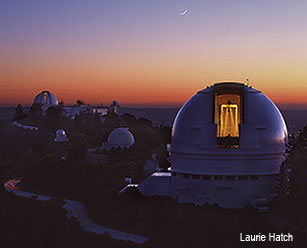As a James Lick HS Alum, I would visit the historic observatory all the time. One fall morning Karen and I decided to take a trip up the hill to visit the Observatory.
The Lick Observatory is an astronomical observatory, owned and operated by the University of California. It is situated on the summit of Mount Hamilton. The observatory is managed from the University of California, Santa Cruz.
The observatory, was constructed between 1876 and 1887, from a bequest from James Lick. In 1887 Lick's body was buried under the future site of the telescope, with a plaque with the inscription, "Here lies the body of James Lick". The Observatory was the world's first permanently occupied mountain-top observatory.
Before construction could begin, a road to the site had to be built. All of the construction materials had to be brought to the site by horse and mule-drawn wagons, which could not negotiate a steep grade. To keep the grade below 6.5%, the road had to take a very winding path, which Mt. Hamilton Rd (SR 130) still follows. It is rumored that this road has exactly 365 turns. The road is closed when there is snow on Mt. Hamilton.
The 36 inch refracting telescope on Mt. Hamilton was the largest refracting telescope during the period from 1888, until the construction of Yerkes in 1897. Warner & Swasey designed and built the telescope, with the 36-inch lens done by Alvan Clark & Sons. In May, 1888, the observatory was turned over to the Regents of the University of California, and it became the first permanently occupied mountain-top observatory in the world. Edward Singleton Holden was the first director. The location provided excellent viewing performance due to lack of ambient light and pollution; additionally, the night air at the top of Mt. Hamilton is extremely calm, and the mountain peak is normally above the level of the low cloud cover that is often seen below in San Jose area. When low cloud cover is present below the peak, light pollution is cut to almost nothing. in 1980 San Jose began a program to reduce the effects of lighting, most notably replacing all streetlamps with low pressure sodium lamps. The result is that the Mount Hamilton site remains a viable location for a major working observatory. Asteroid 6216 San Jose was named in honor of the city's efforts to reduce light pollution by the International Astronomical Union.


There are daily tours inside the telescope housing. The floor is mechanically lifted more than 30' in order to manipulate the telescope in any direction for optimum viewing.
After our tour of the refractor we hiked up to the site where the reflector telescope.
After the Observatory we headed down the hill to Joseph D. Grant county park.its the largest of Santa Clara County's regional park and recreation areas. This 9,560 acre park includes some of the County''s finest open space resources, as well as rich environmental, cultural and recreational assets. The landscape is characteristic of the east foothills of the Santa Clara Valley with grasslands and majestic oak trees. As part of the park''s tradition and history, cattle grazing currently takes place in some areas, and is monitored under a resource management plan.















No comments:
Post a Comment